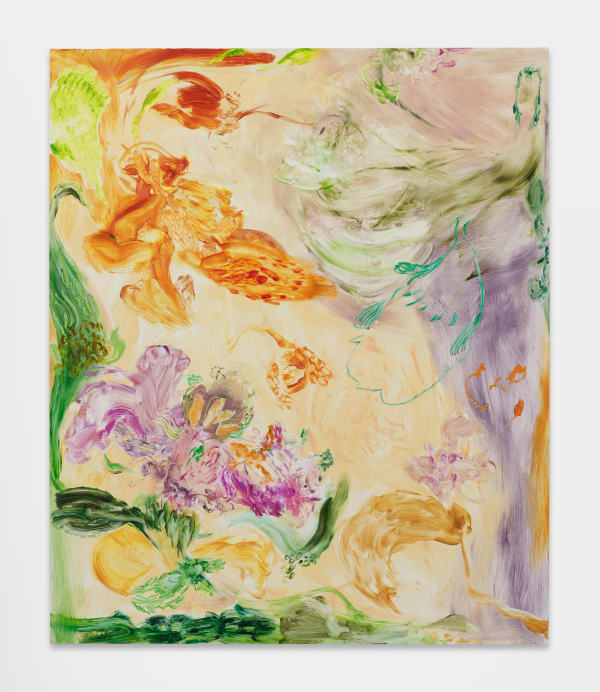Patricia Iglesias Peco: Las plantas de ese jardín conservaban en la sombra sus colores
The evening moon passes by my forehead and says, “You’re dreaming.”
And then everything changes places.
For her latest exhibition, Los Angeles-based Argentinian painter Patricia Iglesias Peco continues her exploration of the natural world by drawing influence from the Uruguayan poet Marosa di Giorgio (1932-2004) and the feminine cosmology elaborated in her writing. A primary setting in her work is YLA, a garden-kingdom where di Giorgio weaves tales of the lives and couplings of the señoras-niñas. In these surreal worlds conjured on the page, Iglesias Peco finds a matrix through which to extend her signature vocabulary of images and gestures. The garden which is central to di Giorgio’s work comes to life in a state of constant metamorphosis where flowers, women, birds, and celestial bodies intertwine in transformative flux. In response, Iglesias Peco paints a seductive tapestry, both fearlessly erotic and beguilingly monstrous, in which organic shapes that recall flowers and inchoate protozoa float through fluid fields of color.
Scholar and translator Jeannine M. Pitas notes that “Di Giorgio’s poetic voice seeks to find her way in a landscape where the borders between reality and dream, memory and desire are never clearly defined.” In much the same way, Iglesias Peco’s paintings are errant wanderings of natural and arcane forms in which complex compositions, recalling the tradition of still life, effloresce in expansive atmospheres of varied hues. Her evocative brushwork varies between seemingly etched marks contouring the liminal borders of positive and negative space that shape her figures and these shimmering patches of violet, azure, and emerald. This intuitive handling of the paint—smeared, stained, or even scratched into the panels—represents an embodied approach in which haptic gestures become the medium for fearless exploration of images and surfaces. Each of the new works of varying scale is held in tension between the beautiful and grotesque, rooted not only in di Giorgio’s erotically Baroque prose poems but also in Iglesias Peco’s representation of a world inflamed by incandescent desire.
Her approach toward rendering the ontological ambiguity of her subjects sustains a lyrical threshold where the everyday and the ecstatic commingle. As Iglesias Peco translates di Giorgio’s texts into images, she finds an unmediated and impulsive freedom, a visual character for the natural supernaturalism that connects painter and poet across years and media. The burning clarification out of which these paintings emerge also brings forth the essential elements of Iglesias Peco’s work, registering a palpable through-line from the shapes and processes she has explored in her earlier work.
This finely calibrated vision for both the sumptuous and the lurid, in which color guides gesture with transformational awe, mirrors the psychic and physical mutability that foregrounds di Giorgio’s poetry. As translator Adam Gianelli writes, “one thing blurs into another: ‘The five white tips of a lily are the same as the five silver points of a star. It’s like a reflection. So the star and the lily transform, while remaining a star and a lily…” The complexity of being two things at once grants these poems freedom from disruptive logic that seek to contain and control. This sense of evasive simultaneity permeates Iglesias Peco’s paintings. However, instead of transcribing the Ovidian narratives directly, she captures still moments in which metaphorically charged landscapes blend indistinguishably into commanding weather, teaming with affective signifiers. The interior ambiguity represented as external space permits the viewer’s mind to explore multiple interpretive possibilities, completing the vibrant mise-en-scène with their own imaginative interventions.
Patricia Iglesias Peco (b. 1974, Buenos Aires, Argentina) lives and works in Los Angeles, California. She studied under acclaimed artists Pablo Edelstein and Philip Pavia and attended the Savannah College of Art and Design and the School of Visual Arts in New York. Iglesias Peco has participated in several group and solo shows, both in the United States and Argentina including: François Ghebaly, Los Angeles; Del Vaz Projects, Los Angeles; Situations, New York; La Loma Projects, Los Angeles; Gladstone Gallery, New York; and James Cohan Gallery, New York. Her work will be included in the forthcoming exhibition Accretions: Works by Latin American Women at the Santa Barbara Museum of Art.
Text by Miciah Hussey
-
 Patricia Iglesias Peco, Tirana y su Ramo de Azucenas, 2024
Patricia Iglesias Peco, Tirana y su Ramo de Azucenas, 2024 -
 Patricia Iglesias Peco, Elvias Violenas Violetas, 2024
Patricia Iglesias Peco, Elvias Violenas Violetas, 2024 -
 Patricia Iglesias Peco, Yla, 2024
Patricia Iglesias Peco, Yla, 2024 -
 Patricia Iglesias Peco, La Madre y Lavinia, 2024
Patricia Iglesias Peco, La Madre y Lavinia, 2024 -
 Patricia Iglesias Peco, La Mato una Estrella, 2024
Patricia Iglesias Peco, La Mato una Estrella, 2024 -
 Patricia Iglesias Peco, El Jardin de Marosa, 2024
Patricia Iglesias Peco, El Jardin de Marosa, 2024 -
 Patricia Iglesias Peco, La Escuela de las pequeñas Señoras, 2024
Patricia Iglesias Peco, La Escuela de las pequeñas Señoras, 2024 -
 Patricia Iglesias Peco, Elveta nacida con secretos, 2024
Patricia Iglesias Peco, Elveta nacida con secretos, 2024 -
 Patricia Iglesias Peco, Opalina Desire Azucena Uva, 2024
Patricia Iglesias Peco, Opalina Desire Azucena Uva, 2024











